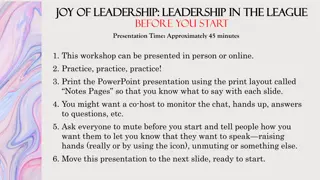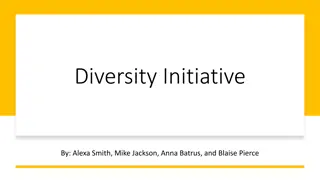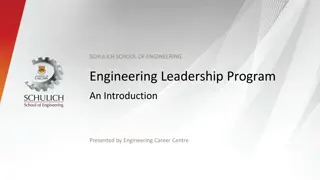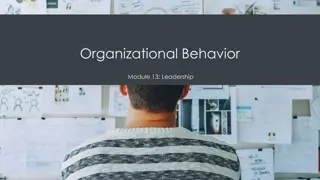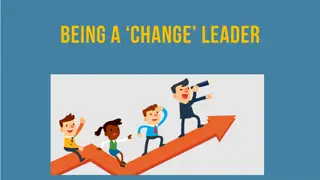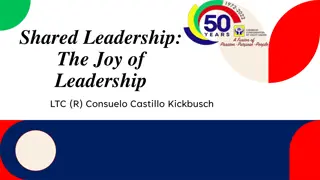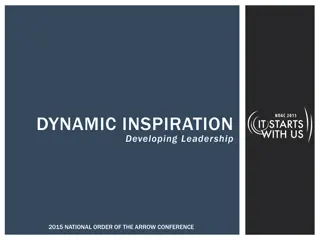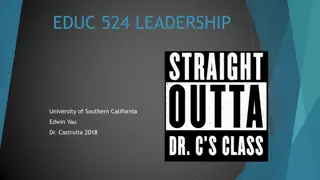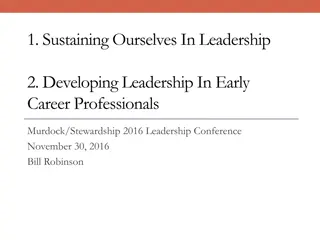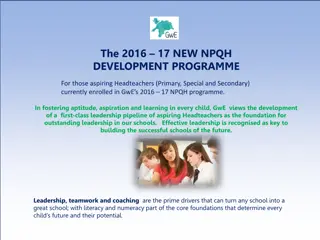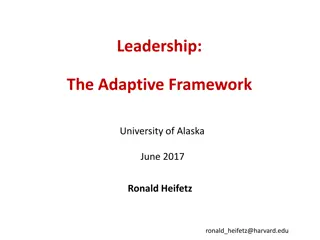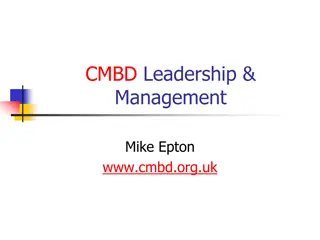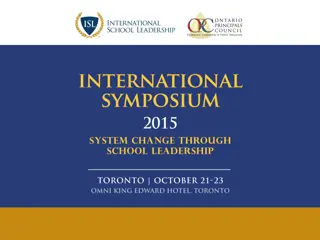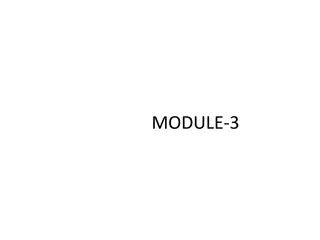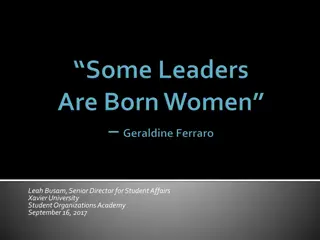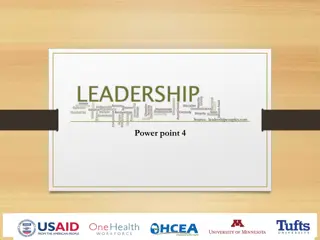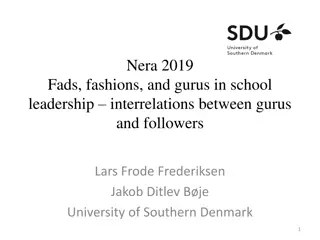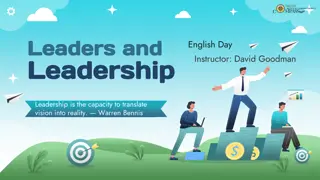School Leadership Roles and Development
The various roles and responsibilities of school leaders, focusing on leadership concepts, building a culture for learning, and improving student outcomes. Dive into the key areas where school leaders invest their time daily and reflect on ways to enhance teaching and learning in schools through effective management of multiple roles.
Download Presentation

Please find below an Image/Link to download the presentation.
The content on the website is provided AS IS for your information and personal use only. It may not be sold, licensed, or shared on other websites without obtaining consent from the author. Download presentation by click this link. If you encounter any issues during the download, it is possible that the publisher has removed the file from their server.
E N D
Presentation Transcript
SCHOOL LEADERSHIP: CONCEPT AND APPLICATIONS
Key Focus of the Module Understanding Leadership Focus on leading by action Building a practitioner s perspective to leadership School Leaders: Multiple roles and identities Administrative Vs academic, Organizational Vs Classroom specific Leading Learning: Improving Student Learning Outcomes Role as academic leader professional development of staff, developing learning environment, academic supervision and feedback Creating a Culture for Learning Promoting professional dialogue and learning, making reading, sharing, critiquing, learning a part of school time-table
My School My Initiative (Activity 1 -10 Minutes) Challenges in my School My initiatives I improved in and my learning I could nt improve and my learning
My Initiatives- Record some good practices from your group(Discussion time 10 minutes)
School Head: Multiple Roles and Responsibilities
What multiple roles do you perform on an average day? In which role is your maximum time invested? Identify 4 key areas where your maximum time in a day is spent Make a pie-chart and plot the key roles on it.
School Leader: Multiple Roles and Identities (Activity 2-10 minutes) Reflect Which of these roles contribute in improving teaching-learning in school Or Develop a learning culture in school? How do I manage time between different roles? How do I contribute more towards improving learning in school? Administrator Manager Liasoning Officer Human Resource Manager Academic Leader/Coach Community mobilizer Team Leader Teacher Examiner Researcher
Researches on role of leadership in improving SLO
10 Essentials for Heads of Schools Most separately, have at most small effects on learning. The real payoff comes when individual variables combine to reach critical mass. Creating the conditions under which that can occur is the job of the principal. (Wallace Foundation, 2011, p. 2) school variables, considered
Contd. Supporting teachers improve their teaching, Using data to review and refine the instructional program Ensuring that the schools are kept clean and safe. Shaping a vision of academic success for all students in all schools, one based on high standards through school networks. (Role for system officials)
Contd. Creating a climate hospitable to education in order that safety, a cooperative spirit and other foundations of fruitful interaction prevail. Cultivating leadership in others so that teachers and other adults assume their part in realizing the school vision. Managing people, data and processes to foster school improvement. (Wallace Foundation, 2011, p. 4)
Contd. Enhancing the skills and knowledge of the people in the organization, Creating a common culture of expectations around the use of these skills and knowledge, Holding the various pieces of the organization together in a productive relationship with each other, and Holding individuals accountable for their contributions to collective result. (Elmore, 2000 p. 7)
Being an Instructional Leader
What is Instructional Leadership? managing curriculum setting clear goals monitoring lesson plans involving colleagues collaboratively in mutual learning and development allocating resources evaluating teaching regularly improve student learning and teacher effectiveness
What is Instructional Leadership? Learning- focused Addressing cultural, linguistic, socioeconomic and learning diversity in the school community Engaging in Learning rounds and Learning Conversation Improving instruction and quality of student learning Developing a culture of public practice and reflective practice
Roles of an Instructional leader (IL) Based on the above understanding of an instructional leader Infer the roles of an instructional leader Make a list of all the roles of IL (Activity 3- 10 minutes) Of these list of roles which roles do you perform?
Activity4 (20 minutes) Individual followed by Small Group Discussion Reflect on how you would become an instructional leader in your context Entry point what do you practice currently and where do you want to improve? Process/Mechanism what new mechanisms you would have to initiate Assessing progress How do you assess change in self, others and processes Potential Challenge How would you transform teaching learning in CR as an instructional leader?
Improving Classroom Observation and Feedback Why conduct classroom observation? Is CrO always about a senior observing a junior or could it be otherwise as well? What are the challenges in CrO? What would be the role of School head/CRC/BRC in CrO?
Activity 5- 20 minutes Ask participants to give their observations on the facilitator s class Record all the observations on board Seek feedback from all on the session that they have been observing Ask them to find out the difference between observation and feedback Underline all observations loaded with opinions, judgments, adjectives or negatives and positives and separate them from objective descriptive statements
Also underline all the statements in the feedback which were either positive, negative or in any way evaluative or judgmental Discuss the pro-cons of giving opinionated observations and feedback Explain the difference between observation and feedback
What is Classroom Observation? Observation is an objective description of all that one perceives through senses see, hear and feel. Observation does not include opinion, perception, evaluation or judgment. It is neither positive nor negative It therefore begins with statements like: I saw I heard .. I felt I noticed I observed
What is feedback? The word feedback is a combination of two FEED and BACK, literally to mean giving back what is given to you .. Such that it makes the person think and reflect on what one has given. Feedback therefore cannot be opinionated Feedback is once again neither positive nor negative It is neither advisory nor suggestive It is also not evaluative or judgmental Feedback has to be REFLECTIVE and is for IMPROVEMENT
What is a Learning Conversation (LC)? LC happens after lesson observation where the observer strictly limits to describing the teaching-learning process reflective thought based on the evidence. thus stimulating It does not indulge into praise or criticism. It is a formative process to help the teacher have a deeper understanding of the teaching- learning process.
Contd. Deeply empowering as teacher develops confidence in their own ability to improve their practice. It replaces the traditional Praise-Criticism-Praise sandwich model to Ask-Describe-Ask process Emphasis is on observers learning and expectation isn't that the group will solve the problem, but that observers will come away with a clearer picture and new ideas about next steps.
Premise/Principle Privacy of practice leads to isolation and isolation is the enemy of improvement. Elmore It is not a deficit model, designed to spot flaw or failure . Stress is on not critiquing an individual but collecting episode so that we can see patterns.
Ask-Describe-Ask Process Ask The observer asks the observee for his/her reflections What were his/her goals around chosen focus area? What went well and what could have gone better? Asking enables the observer to start a dialogue Ensures the colleague is heard Is useful for tailoring feedback Puts the focus on the learning of the colleague
Continue Describe the observer describes what he/she saw Gives descriptive information to the colleague on the chosen focus area Responds to the colleague s view on the lesson Gives feedback on the observee s own self-assessment Uses phrases like I observed . or the following evidence is .. or the pupil said .. It creates a description of what you saw and lays the platform for a discussion about learning and teaching.
Continued Ask understanding and next steps (again) the observer asks about What is our learning? What new understandings have we developed? What could the observed colleague do differently? What could be the next few steps? How do we monitor improvement together?
Praise-Criticism-Praise model You did well and I felt that you kept a tight rein on behavior. However , thought your questioning style was limited and very biased towards the boys. Overall, I enjoyed the lesson. This model is overly reliant on a judgmental tell approach that has the observer telling the observee what and how to improve The challenge for the teacher is in trying to unpack what is being said. If there is lack of trust or hesitation, an effective learning conversation becomes impossible.
Ask-Describe-Ask model At the stage where you engaged with children in question and answer, you posed 12 questions on the topic, nine of the questions were closed ended and ten of the question were posed only to boys. I m interested in your thinking on this? It is a shift from top-down approach to an approach between two individuals involved jointly in a learning enquiry. There is no judgment, the observer gives descriptive feedback designed to stimulate reflective thought. Learning conversation here might focus on closedquestions used to scaffold learning towards more open-ended questions or questions only to boys or lower order questions. Emphasis here is on coaching style rather than telling style.
Why engage in learning conversations? Maximize teacher potential Create opportunity to reflect on their skills Identify ways to developing self Improve performance Provides constructive challenges Provides opportunities to explore ideas Helping them be self-aware, take responsibility for self-growth and development.
Creating a Learning Culture How do you make learning conversations a regular feature of your school? What opportunities does your school currently offer for teachers to come together and learn? Is reflection a part of practice, time table or calendar? Should reflective practice be introduced in school? How would reflexivity change the school culture?
Activity 3: Role Play (30 minutes) Divide the large group into five small groups Let us assume that you all belong to one school Now pick up one challenge that the school wants to overcome through collaborative learning and reflection Let this be a demonstration of an ideal staff/cluster/block meeting that focuses on learning Set an agenda, allot equal time to each speaker, allot responsibility to one member for recording minutes, make common meeting ethics/norms Bring out probable solutions and share it with larger group
How do you sustain learning? THINK SHARE ACT How do you lead school improvement through reflective dialogue and collaborations? Share your knowledge, ideas and exposure with others and encourage and empower them to spread the word Change your practices, habits and develop self sustaining teams through appreciation, support and role modelling
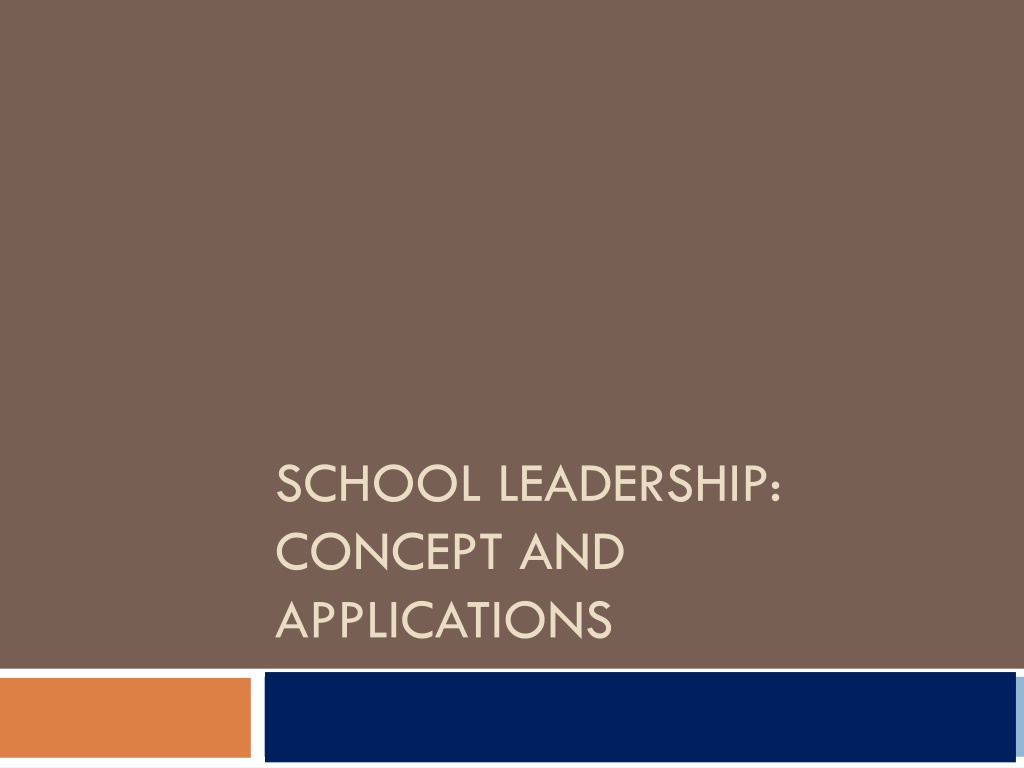
 undefined
undefined




